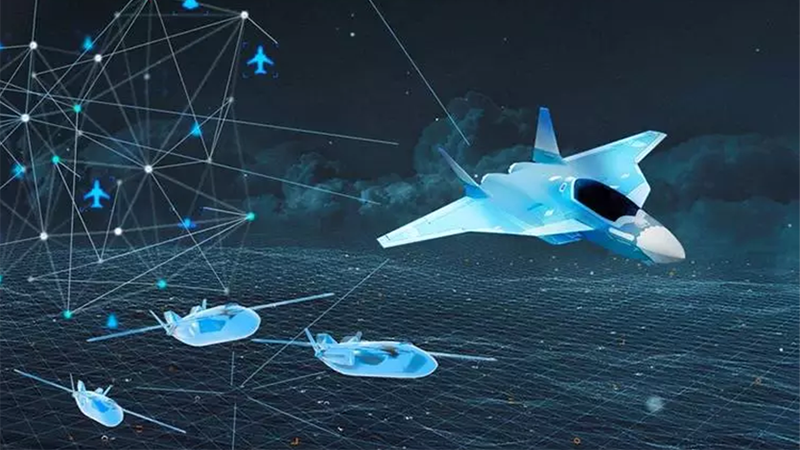
An artist’s illustration of the Future Combat Air System (FCAS) networked system. (Airbus)
MADRID — The Franco-German-Spanish led Future Combat Air System (FCAS) next generation fighter effort will not be following the approach of the rival Global Combat Air Programme (GCAP) by opening up partner nation and industrial collaborations to non-European parties.
GCAP merged the UK Tempest and Japan’s F-X sixth generation fighter programs under an “international coalition” agreement last week, with Italy also a signatory to the new pact. FCAS, on the other hand, will continue as a fully European initiative, according to Airbus officials, at least for the foreseeable future.
“We are not going to sign something with another non-European country in the next couple of years,” said Michael Schoellhorn CEO of Airbus Defense and Space, during the manufacturer’s two-day Trade Media Briefing held this week in Spain. Breaking Defense accepted travel and accommodation courtesies for the event.
Schoellhorn also revealed that “there’s not going to be anything outside of Europe” relating to the newly signed Phase 1B demonstrator contract that paves the way for Airbus and France’s Dassault to develop a first version of the FCAS next generation fighter — now set to make its first flight in 2029 after a two-year delay.
Phase 1B will see the two companies address what the next generation fighter and new drones will look like, before build activities start in Phase 2 and flight testing rounds off development plans under Phase 3. The latter stage will also see the air assets being teamed together for the first time.
“The aim of all of this is to raise technology readiness levels,” said Bruno Fichefeux, head of FCAS at Airbus.
The latest contract followed a tense round of negotiations between the two sides that included Dassault denying a French government claim that an agreement had been reached, and amid reports that integration of flight control systems were a source of industrial dispute.
“I will not go into the details of the [Phase 1B contract] give and take,” Fichefeux said.
Instead, he focused on the industrial agreement being a “very positive step for Europe,” as well as individual and collective sovereignty.
Future FCAS plans include demonstrations and experiments for engines, low observable stealth technology, combat clouds and sensors. Beyond the plane’s first flight, 2028 should see flights for FCAS remote carriers, UAV’s of variable payload.
At an industrial level, 16 “leading companies” are currently involved in the demonstrator efforts behind which sits a wider FCAS supplier “ecosystem,” according to Fichefeux. The various collection of demonstrator phases and technology maturation projects are all ultimately designed to result in a FCAS sixth generation core fighter platform entering service with partner nations in 2040.
Despite the overarching aim of the program, there still remains a distinct lack of information about how industrial workshare plans will unfold, nor clarification of how many demonstrators will be built, where they will be built and whether, at a design level, they will be based only on the Airbus-made Eurofighter or the Dassault-made Rafale technologies.
For its part, Airbus continues to maintain that a demonstrator will be influenced by Eurofighter capabilities. That position could potentially be challenged by Dassault in the future, as it looks to exert influence on demonstrator arrangements and integrate learning from the Rafale program. Unless those issues are resolved in a timely manner, there runs a genuine risk that the program suffers further delay.
“Timeline panning has not changed dramatically,” said Fichefeux. “We had a bit of gap or delay through the [Phase 1B] negotiation, but the ambitions remain the same, needing to design the system for the horizon of 2040.”
He admitted that FCAS “needs to keep pace” with the US Air Force’s Next Generation Air Dominance (NGAD) fighter program, the UK, Japan “and others.”
“We think we are [in a strong position] because of the significant financial effort from France, Germany and Spain to fund the program [next generation fighter demonstrator] for the next eight years.”
He also spoke of a political, industrial and operational “alignment of stars” that he said should “erase any doubt” over previous questions surrounding aircraft carrier capabilities of the next generation fighter or nations being able to arm the aircraft with different weapons.
Addressing those matters, Fichefaux explained that “industry must deliver” because the partner nations have all signed off on future operational requirements.
FCAS continues to work within a Joint Concept Study that will define the design of the next generation fighter and supporting aircraft., but items as essential as the size of the combat jet have yet to be decided, according to Fichefeux.
In a ‘world first,’ DARPA project demonstrates AI dogfighting in real jet
“The potential for machine learning in aviation, whether military or civil, is enormous,” said Air Force Col. James Valpiani. “And these fundamental questions of how do we do it, how do we do it safely, how do we train them, are the questions that we are trying to get after.”


























